2025-11-15 01:03:35
An Office Hours listener asked what I’d say to President Trump if he invited me to the White House. I’ve struggled my whole life with being right vs. being effective. So, as we’re meeting with the president … let’s focus on being effective. We don’t have much common ground, but we’re both fathers. Let’s start there. As we’d likely have only a few minutes, we’d need to be focused — one issue max. The one thing I’d advocate for? I’d make a case for mandatory national service, as I believe that even the most polarized societies can find common ground when it comes to their children. (Yeah, I know, the whole denying SNAP benefits to kids. But it’s my imaginary meeting, so just go with it.)
I believe young Americans are fed up with a country they’re raised to love but that doesn’t love them back. Our spending priorities (entitlements), tax policies (capital gains and mortgage interest deductions), and fiscal priorities (bail-outs of incumbents) are the greatest transfer of wealth from young to old in history. Old people have figured out a way to vote themselves more money, and even if the younger generations aren’t good at it, they can do math.
The unemployment rate among 16- to 24-year-olds is 10.5% — the highest since the pandemic and, excluding that period, the highest since 2016. Zoomers report feeling more lonely, depressed, and anxious, and less successful, than other generations. It doesn’t help that 200-plus times a day they receive notifications on their phone that they’re failing, as their cohort vomits fake wealth/success onto them. The most noxious emission in America isn’t carbon but shame. Young people aren’t facing one crisis but a cascade of them — and that’s made worse by adults who enjoyed the shade of trees planted by others but are now clear-cutting forests meant for the next generation.

My parents belonged to the Greatest Generation. Their collective sacrifice won World War II, while their sense of national identity, forged by service, fueled the prosperity and progress of post-war America. On Prof G Conversations, historian Heather Cox Richardson told me “there was a very different sense of what it meant to be an American” then, adding that people prided themselves not on how much money they made, but how they took care of their communities. Writing about the people who came of age in post-war America, journalist Tom Wolfe coined the term the Me Generation. Prosperity created what Wolfe called “the luxury of the self.” I know that luxury well. I didn’t serve my country — one of my great regrets. Marketplace host Kai Ryssdal, a contemporary and Navy veteran, told me national service would transform America. “We don’t know each other anymore,” he said. “It’s a generational thing.”
At the end of Notes on Being a Man, I close with a letter to my sons, urging them to be patriots — to vote, pay taxes, and be evangelists for America and its values. I encourage them to give others the benefit of the doubt and treat them with respect, if only because they’re fellow Americans. For my boys’ generation, their fellow citizens are strangers. Our connective tissue is fraying. According to Gallup, the youngest Americans are the least patriotic. I believe mandatory national service could help repair the damage by encouraging young people to see themselves as Americans, first and foremost, and to be proud of that identity.
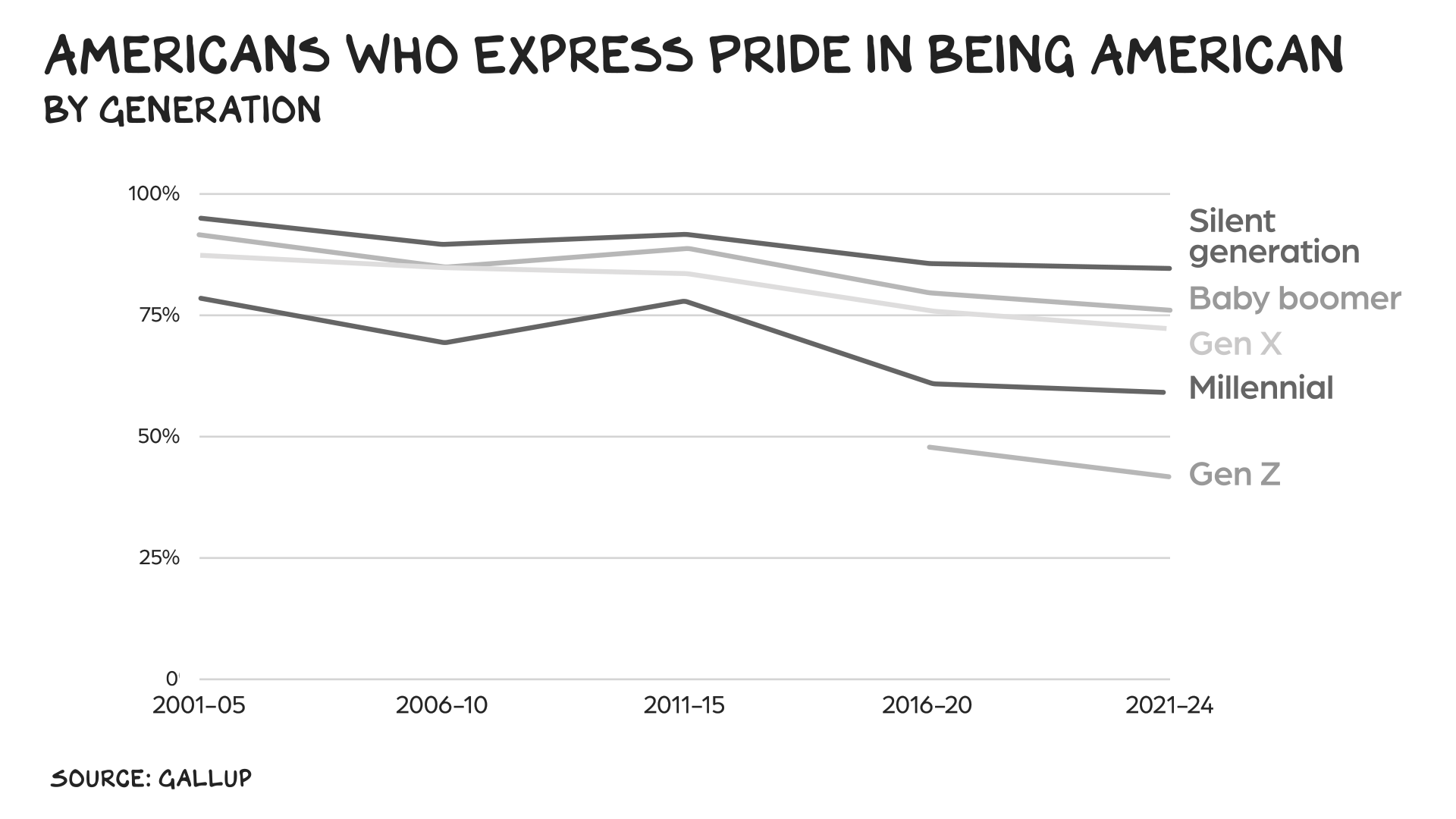
National service in Singapore, the most religiously diverse nation on Earth, is called “school for the nation,” because of its ability to forge a national identity. A study that looked at Singapore’s national service programs concluded that socialization is a key mechanism for transmitting norms and values, while contact with people from different groups reduces prejudice. Those who serve in units that are housed together were 17% less likely to close ranks around their demographic group. By comparison, each year of education beyond secondary school achieves the same effect, but by only 2.5%.
In the U.S., 6% of adults are veterans, while active-duty service members comprise less than 1% of all adults. An estimated 64,000 young Americans and an additional 200,000 seniors volunteer for AmeriCorps, the primary umbrella organization for civilian service programs. We have the programs, but lack scale. Still, we know what works. Democratic Congressman Jason Crow, an Army veteran, favors expanding voluntary national service. On Raging Moderates he said, “When city kids get together with farm kids, and white, Black, Asian, Latino, straight, and gay people roll up their sleeves and build something together … that creates a foxhole mentality that breaks down barriers and connects us.” The sentiment is bipartisan. Republican Senator Bill Cassidy has co-sponsored bills to strengthen AmeriCorps and provide tax relief to volunteers. Republican Senator Todd Young co-sponsored the Unity through Service Act. In 2016 candidate Trump said there was “something beautiful” about national service. On that point, we agree.
Enlisting in the military isn’t the only way to serve. The U.S. has a long history of civilian national service programs. While the mission of each program varies, Congress has historically identified two goals for national service: meeting the needs of communities and developing the capacities and character of participants. Underinvestment in these programs is an American tragedy. As a 2018 NIH report put it, “Higher levels of civic responsibility, voting, volunteering, employment, respect for diversity, and overall life skills such as decision making and time management are all associated with AmeriCorps participation.” We should ramp up AmeriCorps and define service broadly, as our nation’s needs are as diverse as our people. How young people serve — being rural firefighters, volunteering in a no-kill animal shelter, helping seniors, working in our national parks, — isn’t nearly as important as the service itself.
Budgets illuminate national priorities and values. Our three largest expenditures — Social Security, Medicare, and the interest on the debt — are nearly half of the federal budget, mostly benefiting the 18% of Americans who are over 65. The Department of Education and SNAP — spending that overwhelmingly benefits the 30% of Americans under 25 — register 4% and 1.5% of the budget, respectively. To paraphrase Warren Buffet, there’s a generational war in America, and my generation is winning. The D in Democracy only works when wealthy (i.e., old) Americans elect even older Americans who then vote themselves more money.
What if instead of using “the future” and “children” for rhetorical flourish, we actually walked the walk and invested in them? A Brookings report estimated that if we expanded existing national service programs to include 600,000 young people, it would cost $19 billion per year; Americans spent 8x that amount on their pets last year. Scaling up to include all 3.9 million members of the high school class of 2025 would increase the cost to $123 billion. That’s real money, but it’s only about 17% of our nearly $700 billion annual tax gap — the difference between taxes owed and taxes collected. Expanding service opportunities would also generate an estimated 17x return on our investment, according to a 2020 analysis of AmeriCorps programs.
The benefits would be felt across society, as participants would augment nonprofits, as well as state and local government initiatives. Federal and local governments would also benefit from programs that address community challenges early, lessening dependence on other government programs and reducing expenditures in criminal justice, welfare, and public health. Meanwhile, people who complete a national service program would enter college or the workforce with more skills and greater confidence.

National service benefits everyone who serves, but the benefits are likely more profound for boys — a cohort that’s fallen farther and faster than any other group in recent memory. For boys, physical development progresses more rapidly than intellectual or emotional maturity. My friend Richard Reeves has argued in favor of “red-shirting” boys, just as we hold back college athletes for a year so they can develop further on the field. A structured period of one or two years after high school would give boys the opportunity to mature without the pressures of college or a career. It would also give some a second chance. Former IDF boss General Aviv Kochavi called national service a “societal take two” for young Israelis. “It doesn’t matter where you came from or what your background is,” he wrote. “A mediocre pupil or youth with a criminal past who dropped out of school can leave the past behind and become an outstanding leader.” We should give the same opportunity to every young person in America.
If we want our youth to feel invested in their country, then America needs to invest in its youth.
Life is so rich,

P.S. In our newest Prof G Podcast, China Decode co-hosts Alice Han and James Kynge unpack how the U.S. and China are building massive data centers that are reshaping global energy use and government policy. Listen here on Spotify or Apple or watch on YouTube.
The post National Service appeared first on No Mercy / No Malice.
2025-11-07 23:24:16
Donald Trump pulled off a stunning political comeback because of … young men. While the Democrats ignored this demographic, the far right rushed in to fill the void, flooding the manosphere with rockets, Hulk Hogan, coarseness, and crypto. The last presidential election was supposed to be a referendum on women’s rights. It wasn’t. It was a referendum on struggling young men.
Five years ago my advocacy for young men sparked a hostile response. Today society is ready to have a productive dialogue, rejecting the far right’s attempts to send non-white people and all women back to the 1950s and the left’s belief that young men don’t have problems but are the problem. This isn’t a zero-sum game. We can build on the gains women have registered over the past three decades and ensure there’s room for boys and young men in the conversation. Democrats are starting to tackle the crisis, but we can’t rely on prominent party leaders to drive the change. We can count on the tech industry, however, to keep supporting their massive valuations by connecting profits with the sequestration and enragement of young men. Men ages 20 to 30 now spend less time outside than prison inmates.
Men of my generation have a debt to these young men. Our unfair advantage must be paid forward (or backward). We need to get involved in their lives, advocate for policies to right the ship, and model a healthier vision of masculinity. All of us have a role to play in giving young men a code — a positive set of principles — to live by.
Below is an excerpt from my new book, Notes on Being a Man. This one is personal. I hope it resonates with you.
________________
One of the semi-exciting perks of being an academic and “thought leader” is uncovering data, especially when it’s both obvious and hidden. Years ago, the alarming state of American boys and men overtook my attention. I track closely the emails I get. Most are from parents, particularly mothers, concerned about their sons, along these lines: “I have a daughter who lives in Chicago and works in PR and another daughter who’s at Penn.
My son lives in our basement, vapes, and plays video games.” Moms, not dads, were leading the charge. Others were either ignoring the problem or didn’t want to talk about it. Absent, too, was any sober, data-driven analysis. The gag-reflex cultural response seemed to be Wow, men are worse than we think, and that the issues they face are a function of their awfulness, and haven’t we spent the past forty years correctly focused on the struggles of other, more deserving groups?
I connected to this topic on a personal level. I thought back on where I came from, my mom’s irrational passion for my well-being, the generosity of California taxpayers who made it possible for an unremarkable kid with mediocre grades to attend college and business school, and all the obstacles, temptations, and traps that could have easily hampered my socialization — smartphones, online dating, porn, gambling, video games, remote work. I wondered why what was happening to boys and young men was in fact happening and how I could raise my sons in a world where they — and males of any age — thrive.
The data around boys and young men is overwhelming. Seldom in recent memory has there been a cohort that’s fallen farther, faster. Why? First, boys face an educational system biased against them — with brains that mature later than girls’, they almost immediately fall behind their female classmates. Many grow up without male role models, including teachers — fewer men teach K–12 than there are women working in STEM fields — with Black and Hispanic school instructors especially underrepresented.
Post–high school, the social contract that binds America — work hard, play by the rules, and you’ll be better off than your parents were — has been severed. Seventy-year-old Americans today are, on average, 72% wealthier than they were forty years ago.
People under the age of forty are 24% less wealthy. The deliberate transfer of wealth from the young to the old in the United States over the past century has led to unaffordable and indefensible costs for education and housing and skyrocketing student debt, all of which directly affect young men. It’s why twenty-five-year-olds today make less than their parents and grandparents did at the same age, while carrying debt loads unimaginable to earlier generations. Neither the minimum nor the median wage has kept pace with inflation or productivity gains, while housing costs have outpaced both. As the costs of college have soared beyond the reach of most families, many of the manufacturing jobs that didn’t require a college degree and were often a ticket to the middle class for (mostly) men have been offshored. A prohibitive real estate market is a contributing factor to why 60% of young men between the ages of eighteen and twenty-four live with their parents and 1 in 5 still live with their parents at age thirty. Stuck and unable to afford greater economic opportunities in nearby cities, they find the same crush and collision of density, stimulation, humanity, creativity, eroticism, and conversation that urban areas offer on their phones instead. In Manhattan, a four-hundred-square-foot apartment costs $3,000 a month. In its stead is a seventeen-square-inch mobile studio apartment costing roughly $42 a month, served up by AT&T, T- Mobile, or Verizon.
Meanwhile, algorithmically generated content on social media contributes to—and profits from—young men’s growing social isolation, boredom, and ignorance. With the deepest-pocketed firms on the planet trying to convince young men they can have a reasonable facsimile of life on a screen, many grow up without acquiring the skills to build social capital or create wealth. The percentage of young men aged twenty to twenty-four who are neither in school nor working has tripled since 1980. Workforce participation among men has fallen below 90%, caused by a lack of well-paying jobs, wage stagnation, disabilities, a mismatch of skills and/or training, and falling demand for jobs traditionally held by prime-age men.
This is deadly. From 2005 to 2019, roughly 70,000 Americans died every year from deaths of despair — suicide, drug overdoses, alcohol poisoning — with a disproportionate number of those fatalities being unemployed white males without a college degree. Excluding deaths caused by the opioid epidemic, America’s suicide and alcohol-related mortality rate for all races is higher than it’s been in a century. It’s also a mating crisis, as women traditionally mate horizontally and up socioeconomically, whereas men mate horizontally and down. Up until the mid–twentieth century, homogamy — marriages between men and women from similar educational backgrounds — was more common than not. Today, hypogamy, where women marry men who have less education than themselves, is on the rise. When the pool of horizontal-and-up young men shrinks, there are fewer mating opportunities, less family and household formation, and not as many babies. Here’s a terrifying stat: 45% of men ages eighteen to twenty-five have never approached a woman in person. And without the guardrails of a relationship, young men behave as if they have … no guardrails.
Why are we so averse to identifying and celebrating what’s good about men and masculinity, and why does it matter? Because we won’t prosper if we convince boys and young men that they’re victims, or that they don’t have to be persistent and resilient, or that their perspective isn’t valuable. If we do, we’ll end up with a society of old people and zero economic growth. If we can’t convince young men of the honor involved and the unique contributions inherent in expressing what makes them male, we’ll lose them to niche, rabid online communities.
As my Pivot podcast cohost Kara Swisher commented once, it should matter to everyone if men aren’t thriving. Women and children can’t flourish if men aren’t doing well. Neither will our country.
Life is so rich,

P.S. Notes on Being a Man was published this week and is available in all the usual places.
The post Notes on Being a Man appeared first on No Mercy / No Malice.
2025-10-31 23:19:31
At the end of every year, I pick a Big Tech stock I believe will outperform its peers in the coming year. My 2025 pick was Alphabet: I believed the market had overestimated the threats to Google’s search businesses by AI and antitrust. At the time, Alphabet was trading at a P/E ratio of 17, compared to the S&P average of 24. For Alphabet, these “existential” threats were akin to being trapped inside a speeding car with a wasp — potentially serious, in the moment, but in hindsight … more of a nuisance. Today, Google’s search share remains around 90%, and the company is integrating AI into its results. Google, not OpenAI, will likely continue to monopolize search. Speaking of monopoly, Alphabet lost its search and advertising lawsuits, but the remedy/punishment it was given was the equivalent of me threatening (again) to take my son’s phone away (i.e., meaningless). BTW, Alphabet is up 61% year over year, second only to Tesla in the Magnificent 7.
Where the market overestimated Alphabet’s existential threats, I believe it’s underestimating Amazon’s not-so secret weapon (automation) and missing its next growth engine (retail). For more than a decade, people thought of Amazon as a cloud company with a retail unit. AWS and the ad business drove its margin expansion, while on the retail side fulfillment and shipping costs increased faster than sales. Two years ago, Amazon began to reverse that trend. Investments in automation, primarily robotics but also AI, are beginning to deliver operational leverage.
Amazon is projected to have almost 40 delivery fulfillment centers equipped with robots by the end of next year, resulting in an estimated cost savings of $4 billion per year. A Morgan Stanley report estimated that if 30% to 40% of Amazon’s orders in the U.S. are fulfilled through its next-gen warehouses by 2030, the company could save $10 billion a year. Based on last year’s financials, $10 billion in cost savings translates to an additional $170 billion in enterprise value. As the Prof G Markets team observed in our other newsletter, investors are “pricing in AWS’s dominance, but missing the retail margin story,” making Amazon one of the most underappreciated members of the Mag 7. Amazon’s shares are trading at 34x earnings, well below the company’s five-year average of 60x. The stock had been up around 2% so far this year, but it popped after this week’s earnings call on news that AWS revenue had beaten expectations.
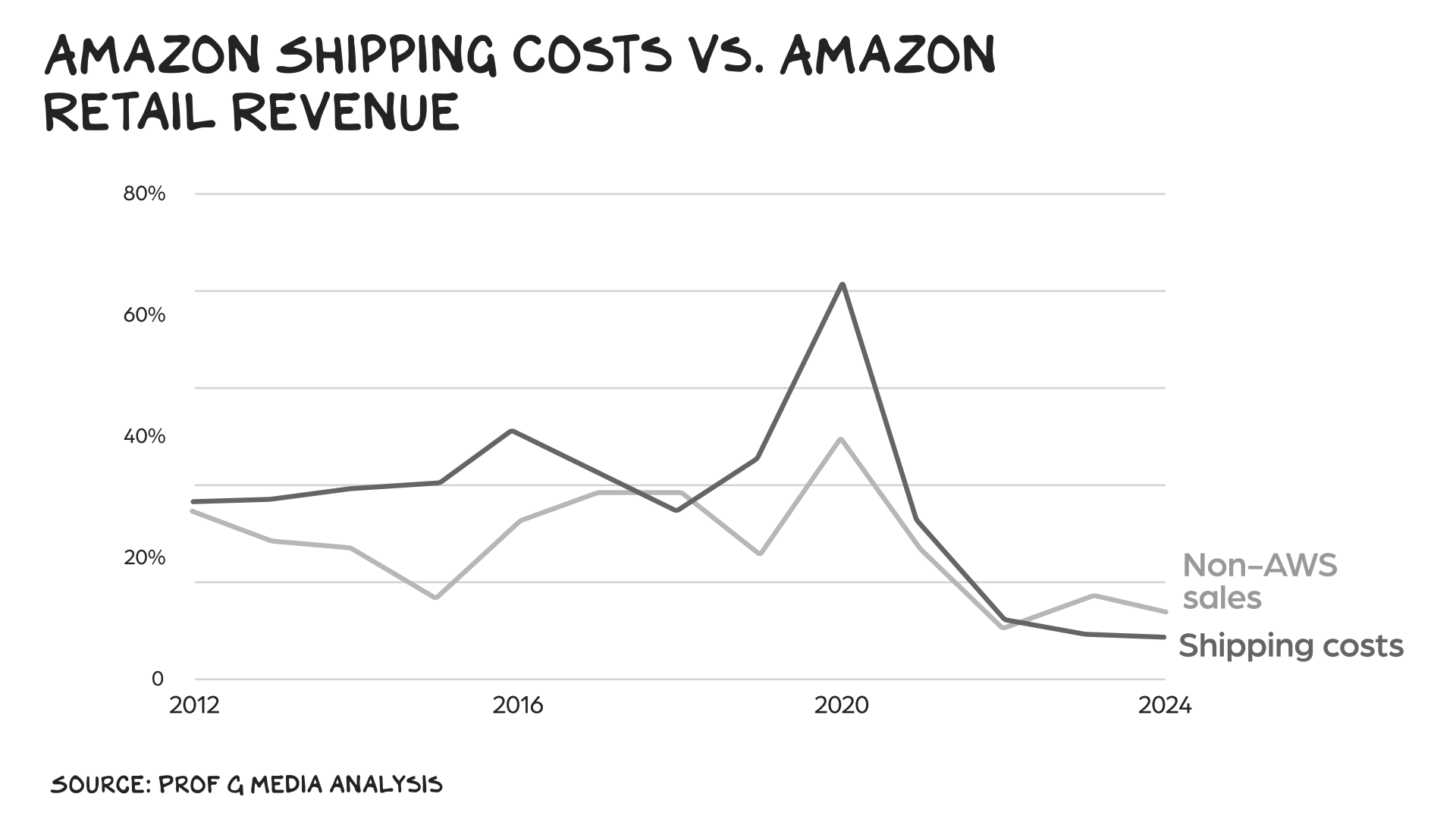
One of technology’s tectonic unlocks has been the elevation of information (bits) over objects (atoms). Our digital lives are (mostly) frictionless. One-click purchasing, personalized algorithmic feeds, and swiping right put shopping, entertainment, and mating at our fingertips. But in the physical world, friction is the defining feature. To fulfill a one-click purchase, Amazon deploys armies of human workers, leveraging machines, global supply chains, and infrastructure. Five companies in the Mag 7 primarily move bits. One, Tesla, moves atoms. Straddling both worlds, Amazon is a logistics company at its core. With 40,000 semitrucks, 30,000 vans, and 110 aircraft (equivalent to the armed forces of Austria, Denmark, or Norway), Amazon excels at moving atoms. The company delivers 60% of Prime orders on the same or next day. According to the most recent data, almost three-quarters of Americans live within one hour of an Amazon fulfillment center.
Recently, I wrote that America’s economy is one big bet on AI. That bet has inflated the valuations of companies that move bits and distracted attention from companies using automation to reduce friction in the physical world. Two-thirds of Amazon’s revenue comes from three segments: online retail, physical stores, and fulfillment services for third-party sellers. Those business lines account for one-third of Amazon’s operating expenses — $26 billion in the last quarter alone. The more it automates, the more Amazon can cut costs in its core business by reducing real-world friction. It’s already happening. According to the Wall Street Journal, Amazon averaged roughly 670 employees per facility last year — the lowest number in 16 years. Meanwhile, those employees now handle 22x as many packages, on average, as they did a decade ago.
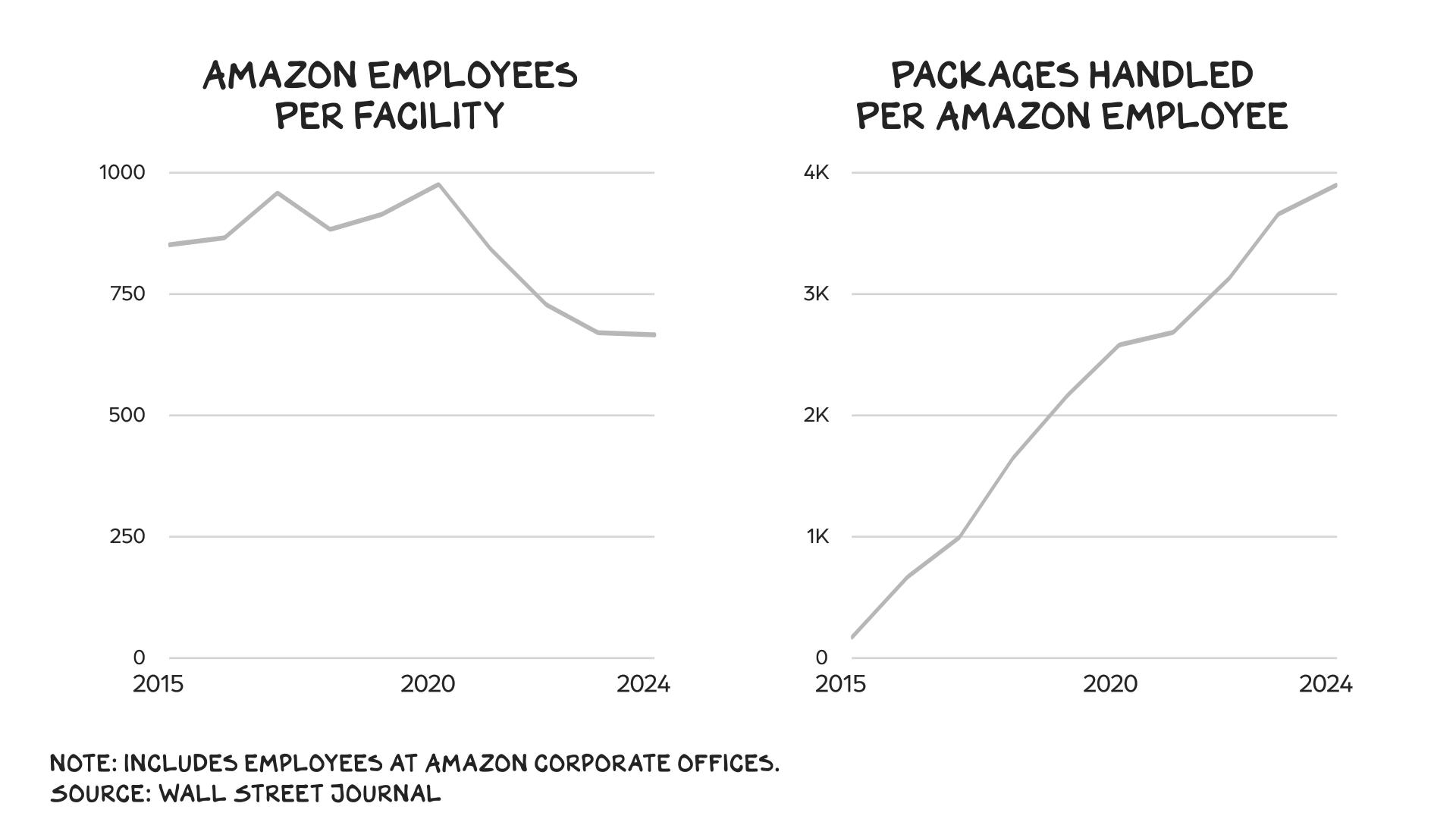
This week, Amazon announced plans to lay off 30,000 corporate employees. That 10% reduction represents the largest cut to headcount in the company’s history, but it’s a fraction of what’s coming for warehouse workers. Amazon’s U.S. workforce has increased 3x since 2018, to almost 1.2 million (70% of the company’s employees are based in the U.S.). But according to the New York Times, Amazon believes that by 2027 it can avoid hiring more than 160,000 workers it would otherwise need in America. Ultimately, Amazon believes it can automate up to 75% of the company’s warehouse operations.
Consider Amazon’s most recent automation milestone. In June, it deployed its millionth robot worker, putting the company on pace to have more robots than humans in its warehouses by yearend. I believe that, just as Mark Zuckerberg, Satya Nadella, and Sundar Pichai dream of AI replacing high-priced tech talent at Meta, Microsoft, and Alphabet, Amazon CEO Andy Jassy dreams of a robot workforce that will never unionize, get injured, demand a raise, go to the bathroom, take time off, or post about poor working conditions on social media. At Amazon’s scale, it’s not a robot workforce, but a robot nation. One of the fears about AI is that it could build a robot army that turns on us. It’s here, it’s Amazon, and (so far) it’s not looking to kill us. It will replace a lot of us, though.

Amazon began investing in robotics a decade ago, purchasing Kiva Systems for $775 million. Since then, Amazon has identified six categories of automation: movement, manipulation, sorting, storage, identification and packing. A robot called Hercules moves heavy carts, while another, Pegasus, sorts and shuttles packed orders. A robotic arm called Sparrow, designed to replace human pickers, is capable of handling 200 million different products of varying sizes and weights. A new address labeler can label 3,000 packages per hour. In tests, Amazon says Sequoia, an automated inventory management system, can process packages 25% faster than its current management system at a quarter of the cost.
This year, Amazon plans to spend $100 billion to capture what Jassy called a “once-in-a-lifetime business opportunity,” adding that “the vast majority of that capex spend is on AI for AWS.” But investments in AI are paying dividends in robotics as the technologies converge. As a Citigroup report put it, “AI is a huge upgrade to robotics,” allowing robots to see, move, talk, learn, and act. It’s the difference between a robot programmed to perform a task and one capable of doing any task within its physical constraints. If you’ve taken a Waymo, you’ve seen convergence firsthand — the car is a robot operated by an AI driver. At Amazon, the peanut-butter-and-chocolate combo of AI and robotics shows up in three ways:
Unlike other jobs, loading and unloading trucks is primarily done by humans even in the most automated warehouses. It’s the same story for last-mile delivery; Amazon’s goal is to deliver 500 million packages per year via drone by the end of the decade, but for now it relies on humans to deliver more than 6 billion packages annually. This is dangerous work, akin to playing Tetris with heavy weights, often in extreme heat or freezing cold. According to BLS data, transportation and warehouse workers sustain serious injuries at twice the rate of manufacturing workers and nearly 4x the rate of workers in mining, oil, and gas.
Last year, Tye Brady, chief technologist at Amazon Robotics, described the tactile skills and situational awareness needed to load and unload a truck as the “holy grail of robotics,” adding “we aren’t there yet.” We is the operative word. This year, DHL ordered 1,000 robot truck-loaders from Boston Dynamics. Through its $1 billion Industrial Innovation Fund, Amazon invested in Rightbot, a startup that designs robot truck-loaders. As soon as a robot truck-loader comes online, it’ll connect with two other robot systems — Cardinal and Proteus — that sort packages and move them to the loading dock. When that happens, some of America’s most dangerous jobs will (mostly) vanish.
Automation represents a massive wealth transfer from Amazon’s workers to its shareholders and customers. Leaked documents show the company hopes to automate away 600,000 jobs by 2033. An MIT study found that adding one robot to a local area reduces employment in that area by six workers. A 2019 Oxford Economics report estimated automation could displace 8.5% of the global manufacturing workforce by 2030. As with AI, it’s possible that robotics will increase GDP while reducing employment.
Five years ago, my friend Andrew Yang ran for President with the slogan “Humanity First.” He warned that we needed to prepare humanity if/when automation decimates labor. This year, President Trump’s Big Ugly Bill made 100% bonus depreciation permanent for machinery, robotics, and automation equipment, while simultaneously gutting healthcare, education, and social safety net programs.
Tax policies illuminate a nation’s values. Our policies suggest we want to birth robots faster and expedite the death of workers.
Life is so rich,

P.S. I’ll reveal the full list of my 2026 Predictions at a free live event hosted by Section. Sign up here.
The post Big Tech Stock Pick of 2026: Amazon appeared first on No Mercy / No Malice.
2025-10-25 00:06:43
America is now one giant bet on AI. If not for the Magnificent 10, the markets would be flat for the year. There’s a different technology that offers more asymmetric upside. If we want to transform the economy — and the well-being of Americans — we should focus on GLP-1, not GPT-5.
More than 40% of American adults — 100 million people — are struggling with obesity. By 2060 half of U.S. adults may be obese. The healthcare costs of all that extra weight could exceed $20 trillion over that period.
Our debt — $5 trillion in receipts vs. $7 trillion in spending — has become the IED of our economy. We don’t know when or why it will detonate. If we’re going to have an adult conversation re spending, all roads lead to the same place: healthcare. We spend $13,000 per person, versus $6,500 in the rest of the G7. Matching the efficiency of our peers would save us $2 trillion a year.
Why do we spend double to die sooner, while experiencing more anxiety, depression, and chronic illness? Our problem isn’t vaccines, food dyes, or Tylenol. It’s fat. The Milken Institute and McKinsey have estimated that obesity costs us about $400 billion annually in direct medical costs and lost productivity.
U.S. healthcare isn’t about caring for health — it’s about monetizing it. Just as Big Tech found the gangster app for shareholder value (rage), the industrial food, hospital, and pharma complexes have found obesity. They get you addicted to sugar and salt, then hand you to the “non-health” complex for replacements, dialysis, and statins. They’ve even rebranded disease as identity: You’re not obese, you’re living your truth. No — you’re finding diabetes. McDonald’s and Coca-Cola celebrate obesity so UnitedHealthcare can monetize it. These stocks aren’t equities; they’re obesity indices.

We know exercise, healthier food, and less screen time help. But they’re not enough. The good news: Obesity may have peaked in the U.S., and we have the tools to actually reverse it. Pushing for a radically lower price and rolling out weight-loss drugs to tens of millions of Americans could be revolutionary — possibly the best civic investment in recent history.
In sum, our instincts have not kept pace with industrial production, and we gorge. GLP-1s put scaffolding on our instincts. Most of us have friends or colleagues we barely recognize after they’ve taken novel weight-loss drugs. By mimicking a hormone called GLP-1, the medicines suppress hunger and make us feel fuller longer. The results are dramatic — 15% to 20% reductions in body weight — yet uptake remains small relative to the tens of millions who could benefit.

Coverage is patchy. Only 30% to 40% of commercial plans and 14 state Medicaid programs cover the cost of GLP-1s for obesity. The administration is considering a pilot to expand coverage under Medicaid and Medicare — a shift in policy after rejecting a Biden-era plan that would have cost $35 billion over 10 years.
Prices need to fall for the math to work. If Medicare began covering GLP-1s, researchers estimate 3 million beneficiaries would start using them over the next decade at a gross cost of $66 billion and savings (in avoided healthcare spending) of $18 billion — for a net price tag of $48 billion.
Costs are moving in the right direction. Wegovy and Ozempic now run under $7,000 a year; Costco offers a monthly supply of obesity drugs for $499; and competition from Lilly and others is driving prices down. More than 100 next-generation obesity drugs are in development, including pill versions.
President Trump on Oct. 16 vowed to slash GLP-1 prices to $150 a month to match the expense in other developed nations, but no deal yet exists with drugmakers. Investors, however, took him seriously: Shares of Novo Nordisk and Lilly dropped sharply on the news.
Economist Emily Oster argues the budgetary worries of expanding access are overstated. Medicaid tends to pay far less than private insurers, and a “typical” 53% discount could drop monthly costs to $235. If 10% of eligible patients took the drugs, it would raise Medicaid spending by just 0.4%.
The concerns also miss the upside: About 5 million U.S. adults use GLP-1s today. If 30 million did, Goldman Sachs estimates GDP would rise as much as 0.8%. At 60 million, the increase could exceed 1%.
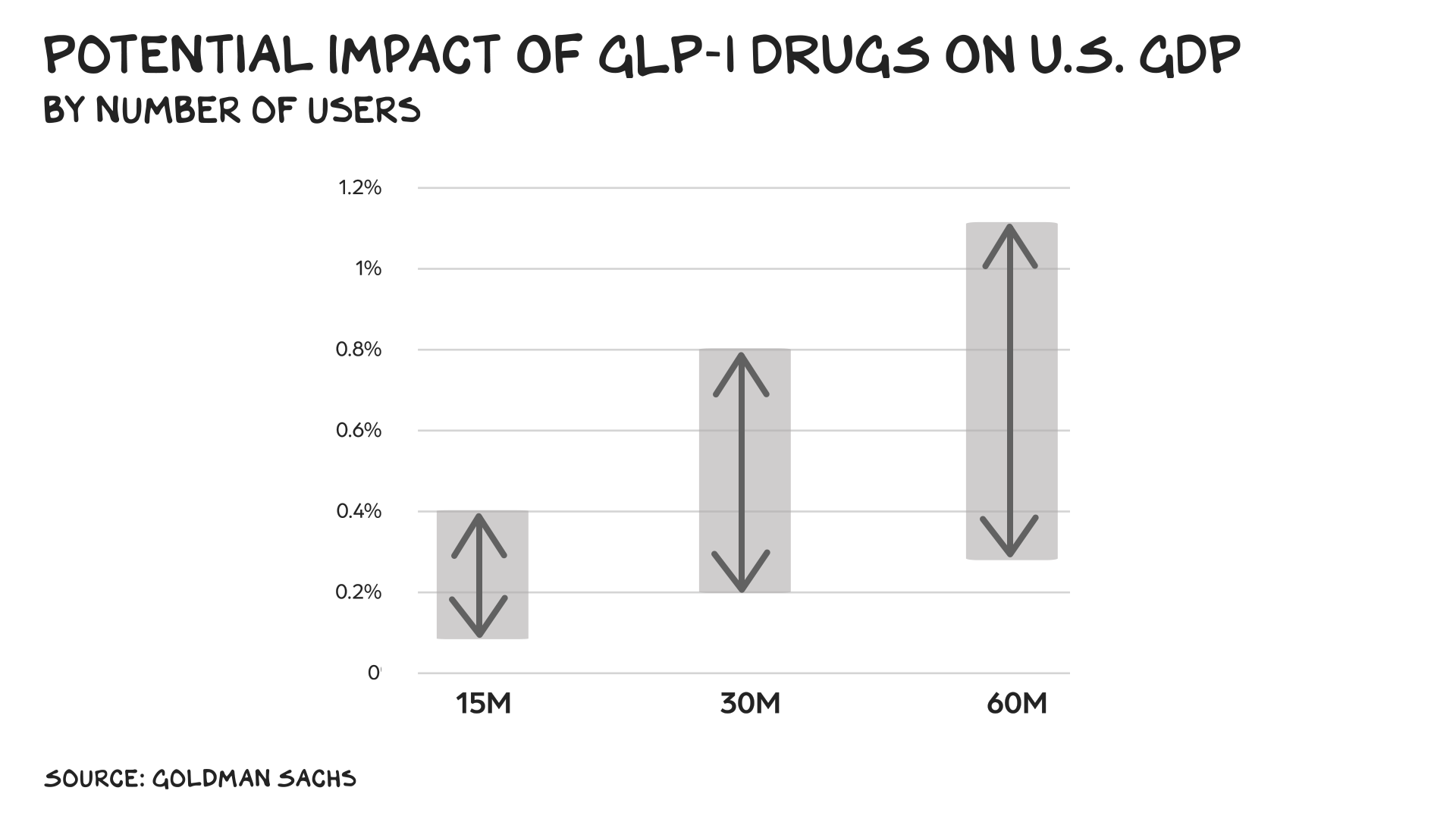
America isn’t the only country fighting this epidemic. In Britain, obesity costs the economy £31 billion a year in lower productivity, sick days, and early deaths. “We’ve created a food system that’s poisoning our population and bankrupting the state,” says Henry Dimbleby, co-founder of Leon restaurants, which bills itself as a purveyor of fast but healthy meals.
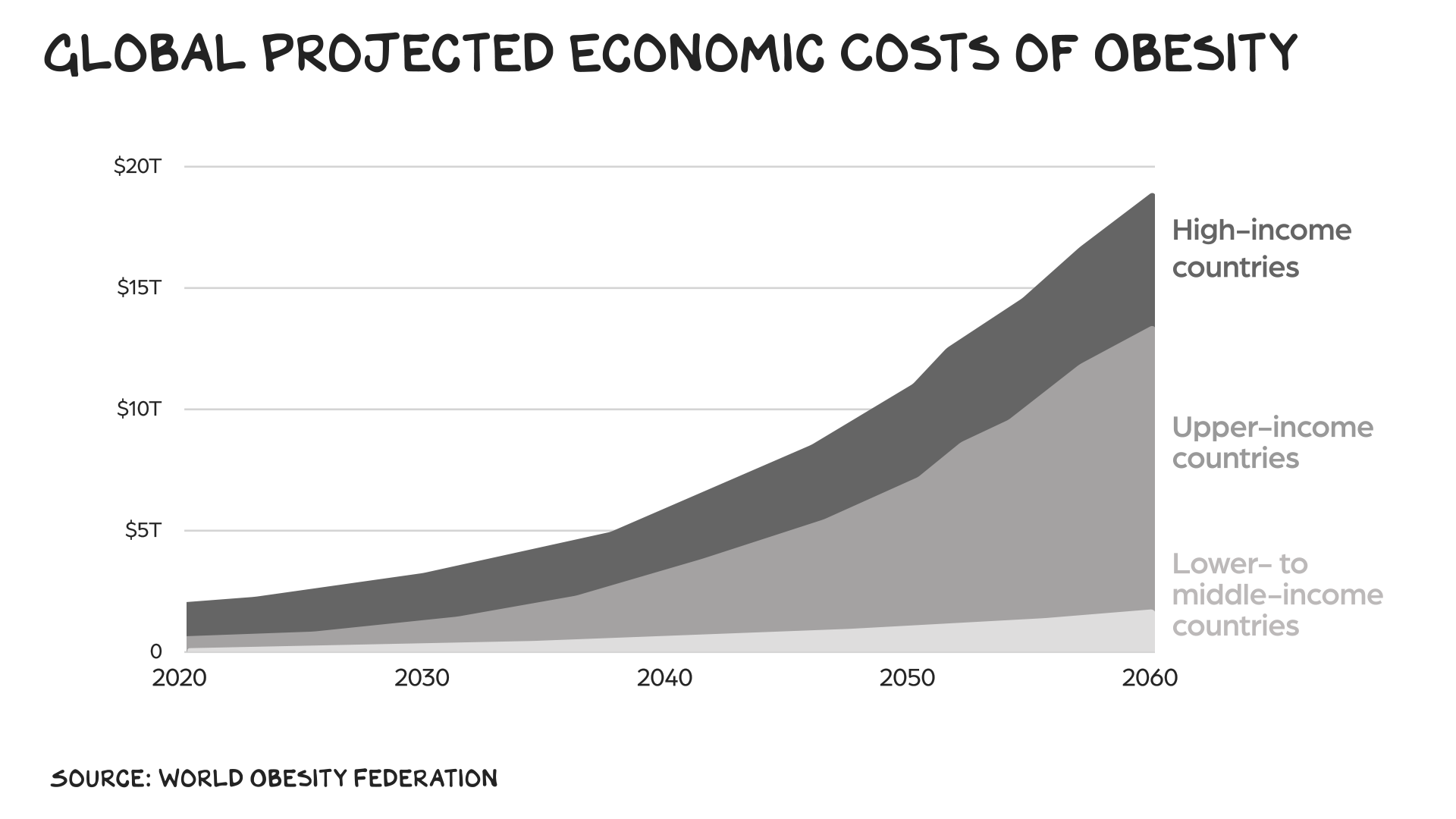
These drugs aren’t a silver bullet, but they are a bullet. Many people quit taking them within a year or two, often because of cost or gastrointestinal side effects, and lasting success still requires exercise and diet changes. But alongside those measures, GLP-1s may be the key to fighting a complex disease rooted in physiology, environment, and policy as much as behavior.
In a society addicted to ultra-processed food and sedentary hours lost in front of screens, we need new weapons. Former FDA commissioner David Kessler calls GLP-1s a way to “defuse the ultra-formulated food bombs” that have hijacked our health.
RFK Jr. has called for “lifestyle” changes while cutting NIH funding — the moral equivalent of telling people to lift weights while closing the gym. The administration’s “Secretary of War,” Pete Hegseth, has shamed “fat generals” but offers no help other than performative masculinity.
Scaling access could prevent adult obesity from topping 50% — and push it back toward 30%. Giving 10 million Americans GLP-1s and lowering their monthly cost to $50 would run $12 billion over two years. That’s a bargain. Targeting the patients most likely to benefit would improve returns further. Obesity shortens life expectancy by up to 10 years, partly because it increases the risk for more than a dozen types of cancer. Reducing its prevalence would yield massive health and productivity gains over the next 30 years. I’m sticking with the thesis I shared with Bill Maher two years ago: GLP-1s will have a bigger impact on the real economy than AI.
OpenAI’s Sam Altman calls Sora “the most powerful imagination engine ever built.” In reality it’s an endless feed of digital slop, further blurring the truth. The real engine of progress comes in a syringe. Maybe we should put it in the water.
Researchers are aiming to preserve muscle and overcome one of the drawbacks with the first treatments, or eliminate injections altogether. They’re also testing GLP-1s to treat conditions beyond obesity. Novo Nordisk is betting its drugs can work against Alzheimer’s. Whether or not these efforts succeed, the trajectory is clear: This technology could reverse the most expensive disease in history.
America’s two great growth engines are rage and carbs — AI monetizes the former, the food complex the latter. GLP-1s may finally break the loop: shrinking our waistlines, cutting costs, and reminding us that progress isn’t digital, it’s biological. The next great platform isn’t the neural net — it’s the needle.
Life is so rich,

P.S. On Raging Moderates this week, my co-host Jessica Tarlov spoke with David Frum of the Atlantic about the Democratic Party’s predicament — and the value of tacking to the center.
Listen here on Apple or Spotify, or watch it here on YouTube.
The post America’s Best Bet appeared first on No Mercy / No Malice.
2025-10-18 00:52:49
The top 10 stocks in the S&P 500 account for 40% of the index’s market cap. Since ChatGPT launched in November 2022, AI-related stocks have registered 75% of S&P 500 returns, 80% of earnings growth, and 90% of capital spending growth. Meanwhile, AI investments accounted for nearly 92% of the U.S. GDP growth this year. Without those AI investments, Harvard economist Jason Furman noted, growth would be flat. As Ruchir Sharma concluded in the Financial Times, “America is now one big bet on AI,” adding, “AI better deliver for the U.S., or its economy and markets will lose the one leg they are now standing on.” This concentration creates fragility, and how the end begins becomes more visible.
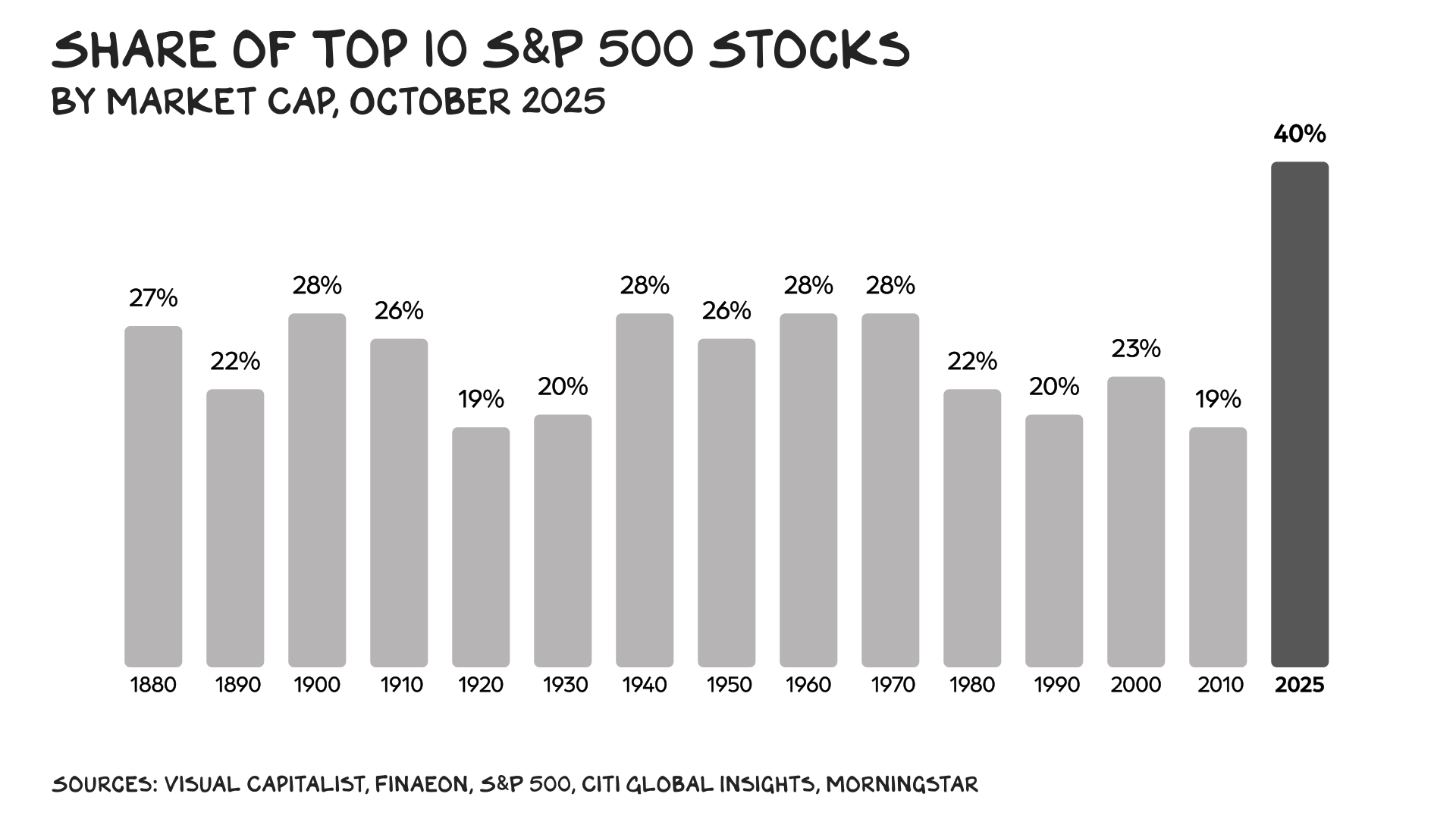
I’m especially proud of the above header, and there is a connection. The S&P, Nasdaq, and DJIA are some of the most damaging metrics in modern history as they create the illusion of prosperity, even as depravity rages on. The cloud cover for a masked, secret police terrorizing communities is these indices. As long as your 401(k) is going up, then everything must make sense and be okay, no? No. Trump could not send troops into U.S. cities if the S&P were down, vs. up, 13%. AI stocks, and the sugar high they have inspired across the entire market, numb Americans from the nagging tooth pain that we are descending into fascism. Yeah, those evil people who wipe your grandma’s ass, pick our crops, and build our homes can be treated inhumanely as long as Nvidia remains worth more than the entire German stock market.
Valuations for the Mag 10 — the original group of seven leading tech stocks, plus AMD, Broadcom, and Palantir — are high, but not yet at historic peaks. The 24-month forward P/E ratio of the Mag 10 is 35x. In 2000, at the height of the dot-com bubble, the top 10 stocks traded at 52x forward earnings. Implicit in these valuations, however, is an assumption that AI will help these companies cut costs, or grow revenues by $1 trillion in the next two years. I believe we’re either going to see a massive destruction in valuations, infecting all U.S. stocks and global markets. Or we’re going to see a massive destruction in employment across industries with the highest concentrations of white-collar workers. Both scenarios are ugly.
If Mag 10 valuations are cut in half, the S&P and global markets would decline by 20% and 10%, respectively. In the U.S., the immediate impact would be felt by the wealthiest 10%, who own 87% of the stocks. Those households won’t struggle to pay their bills, but they may be the tail of the whip on the economy, as wealthy households have the luxury of decreasing their spending dramatically, vs. middle-class households, who spend the majority of their income on basics. If the top 10%, who account for half the consumer spending in the U.S., hit the brakes, the nation gets whiplash. I estimate that if the wealthy see their portfolios drop by 20%, we could see a 2-3% decline in GDP. For context: From peak to trough, the Great Recession registered a 4.3% drop in GDP.
If the Mag 10 justify their valuations by delivering $1 trillion in cost-cutting (Latin for “layoffs”), the impact will hit white-collar workers first, but the contagion could spread. Assuming an average white-collar wage of $100,000 per year, that’s 10 million jobs lost and a 6% increase in unemployment. That estimate is conservative compared to the “white-collar bloodbath” predicted by Anthropic CEO Dario Amodei, who told Axios, “AI could wipe out half of all entry-level white-collar jobs — and spike unemployment 10%–20% in the next one to five years.” The IMF warns that 60% of jobs are already exposed to AI in advanced economies and 40% in emerging markets. According to Okun’s Law, for every 1 percentage point increase in the unemployment rate, real GDP falls by approximately 2 percentage points. But AI could be a different story, with some experts predicting jobless growth. According to a J.P. Morgan report, AI may do to white-collar work what automation did to middle-skill jobs like sales, manufacturing, and construction in the 1980s. The canary in the coal mine may be recent college graduates. Stanford economists found that early-career workers (ages 22 to 25) in the most AI-exposed jobs have experienced a 13% relative decline in employment. If this trend accelerates, today’s challenges around wealth inequality and political volatility will seem quaint.
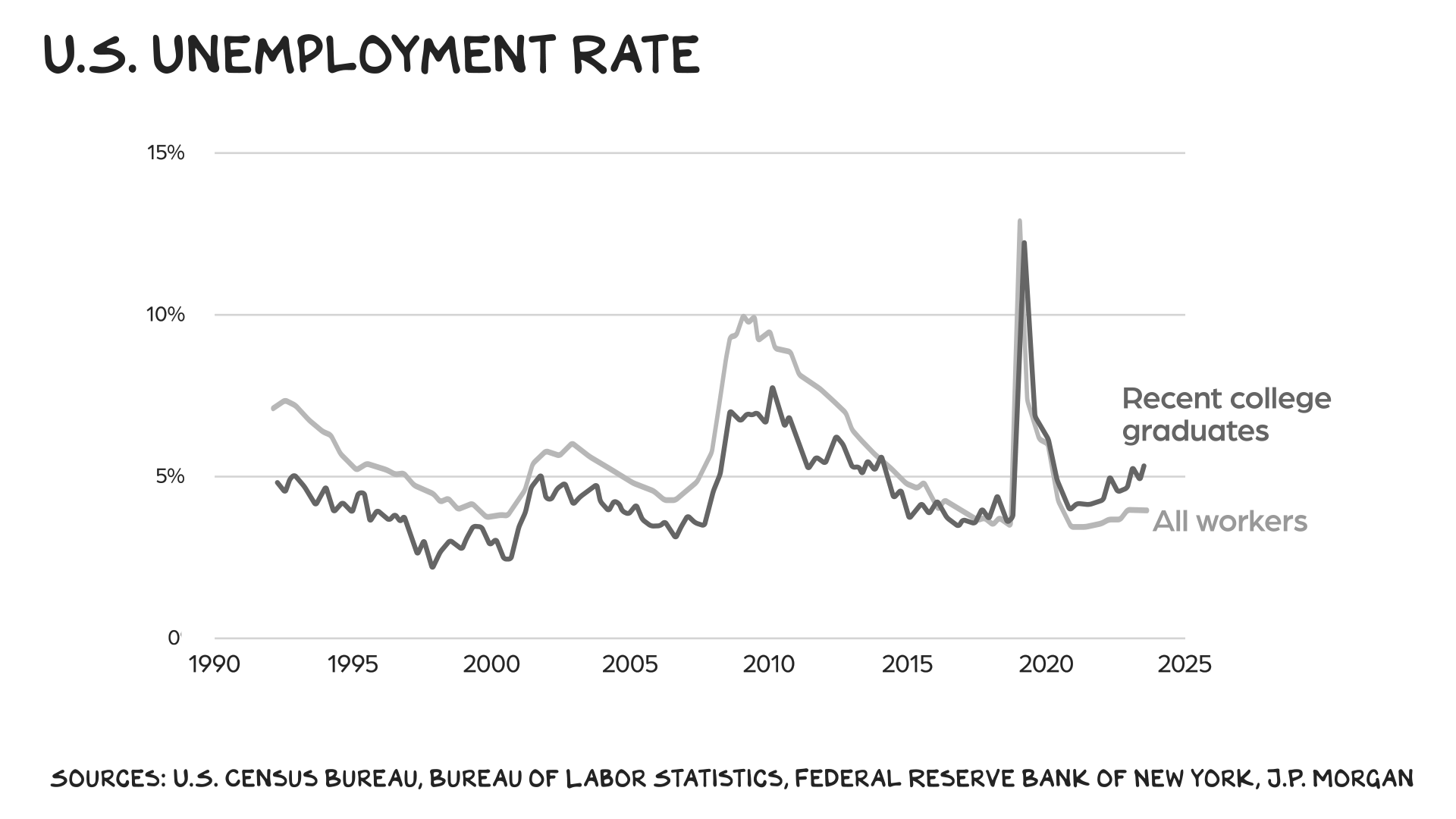
A 2018 study that examined 51 innovations between 1825 and 2000 found 37 were accompanied by bubbles. The destruction that followed in each bubble’s wake, however, varied greatly, depending on several factors. Bubbles inflated by political policies are more destructive than those inflated by new technologies, according to economic historians William Quinn and John Turner. The size of the capital investment is also important. British railway investment in the 1840s was 15%–20% of GDP. When that bubble burst, unemployment doubled. In the U.S., railroad capex averaged 2.4% of GDP in the 1870s. That bubble drove the financial panic of 1873. In both cases, however, those investments paid (delayed) dividends in the form of rail capacity that helped distribute the promise of the Industrial Revolution. In contrast, as The Economist noted, the capex by electronics firms in the 1980s fueled Japan’s asset price bubble, but the spending “ultimately served no useful function.” Finally, the severity of a crash depends on who takes the losses. A second British rail bubble in the 1860s hit banks hard. The recent NFT bubble was a case study in the greater fool theory, but the contagion didn’t reach the broader economy.
You can’t predict when/if a bubble will burst, but Azeem Azhar, founder of Exponential View, and researcher Nathan Warren, created a framework that compares historic bubbles with AI today. In their estimation, AI is a boom, but “booms can sour quickly and there are several pressure points worth watching.” If AI capex exceeds 2% of GDP, that’s cause for concern; it’s currently estimated at around 1.3%. A sustained fall in enterprise or consumer spending levels is another pressure point. A flawed, though perhaps directionally correct MIT study, rattled the AI ecosystem claiming that 95% of firms have yet to see measurable ROI from their AI pilot programs. We’re approaching a valuation redline if/when P/E ratios reach the 50x to 60x range. Finally, if internal cash covers less than 25% of capex, Azhar and Warren believe investments in data centers will come under pressure.
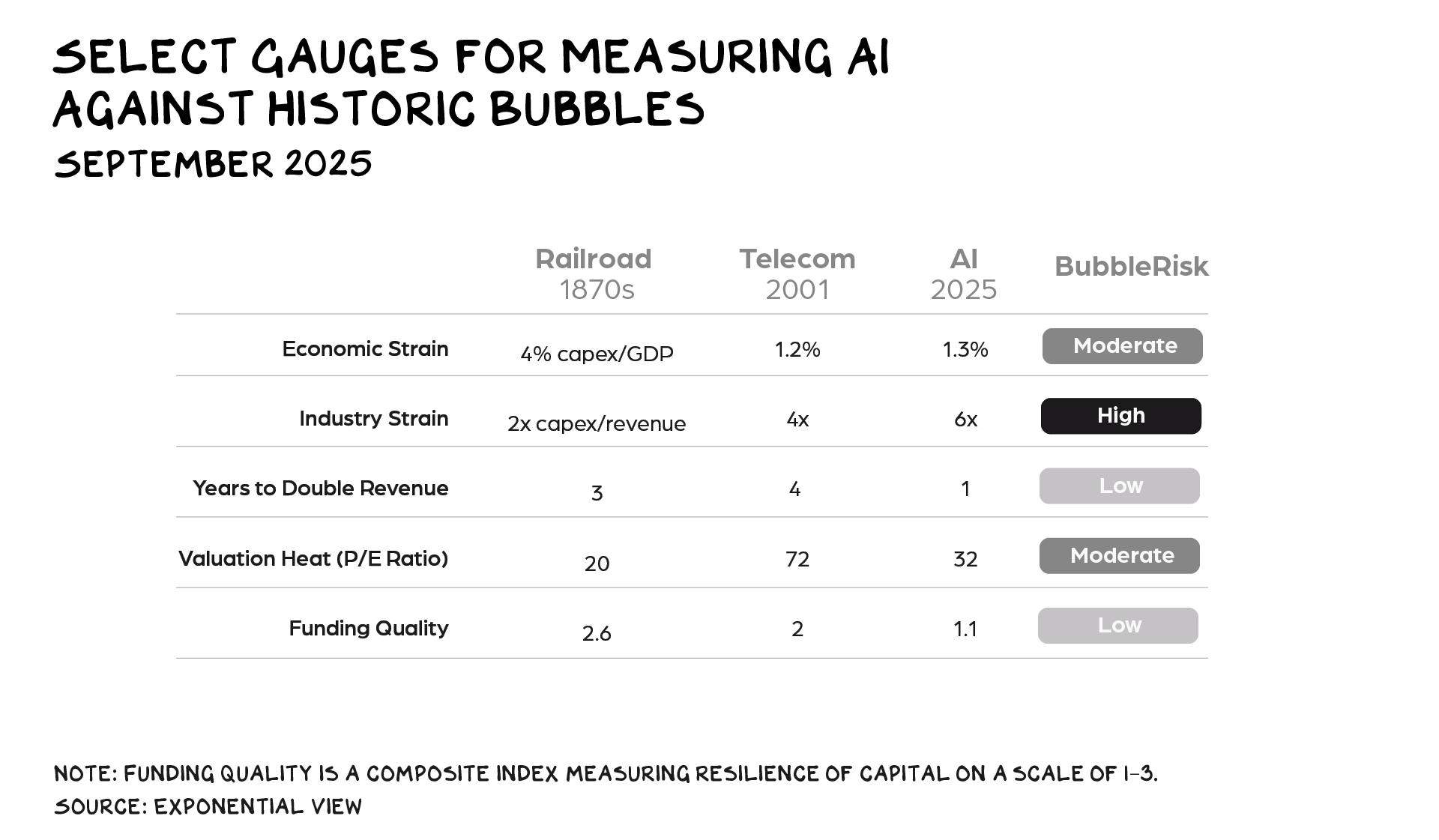
The AI infrastructure build-out has accelerated recently with an estimated $1 trillion in new commitments. Some firms are making deals with money and assets that don’t yet exist. See: OpenAI promising Oracle $300 billion — money it doesn’t have — for infrastructure Oracle hasn’t built. In other cases, revenue comes from “circular financing,” where dollars rotate between firms, obscuring true market demand. See: Nvidia’s $100 billion investment in OpenAI, which OpenAI will use to buy … Nvidia chips. Circular financing deals were common toward the end of the dot-com bubble, when similar deals contributed to a crash that destroyed 77% of Nasdaq market value. If we are on the precipice of a bubble popping, Nvidia and OpenAI will likely be ground zero. But the fallout would be widespread, as an ecosystem that resembles an ouroboros lives and dies by a shared narrative.

In his book Irrational Exuberance Robert Shiller wrote, “The word ‘bubble’ creates a mental picture of an expanding soap bubble, which is destined to pop suddenly and irrevocably. But speculative bubbles are as easily ended; indeed, they may deflate somewhat, as the story changes, and then reflate.” The operative word is “story.” Entrepreneurs, aka storytellers, deploy narratives to capture imaginations and capital in order to pull the future forward. Valuations aren’t a function of balance sheets, but of the stories that give those balance sheets meaning and direction. In the case of AI, a key storyline is shifting. A Prof G analysis of ChatGPT data found that work-related prompts fell from 47% in 2022 to 27% in 2025; ChatGPT has 76% market share. As my Markets cohost Ed Elson said, “the bull case for AI is that it’s going to transform work, but what we’re learning is it’s mostly just affecting your personal life.”
The trouble isn’t the shifting narrative, but the fragility of America’s bet on AI and wealthy consumers driving growth. If McDonald’s goes out of business, the fast-food industry will continue to meet demand for cheap calories; the industry is robust (i.e., anti-fragile). J.P. Morgan, now worth more than the 10 biggest banks in the EU combined, is too big to fail. America’s bet on AI is now a bet without hedge. If companies that aren’t the Mag 10 (i.e., the S&P 490) report they’re scaling back AI investments as the adoption layer fails to launch, the connective tissue between AI, trillions in market cap, and the broader economy severs. The experts have already deemed the grid and electrons as the gating factor to our AI future. However, they’re ignoring a more glaring possibility: AI may be more like VR than GPS and just not offer the ROI built into these valuations. Also, citizens burned by tech executives writing books on gender balance as they launch products that result in teen girls cutting themselves may decide character AI and porn are disastrous for our sons.
If China’s AI program produces another “Sputnik moment” similar to DeepSeek earlier this year, valuations for U.S. AI firms could tumble. And if reports including Apple’s “The Illusion of Thinking” extinguish the hope that artificial general intelligence is near, AI, and by extension the American economy, may experience a significant correction. We’re the biggest economy in the world and the most powerful nation in history. However, concentrating wealth in so few hands, betting on so few companies, makes us fragile.
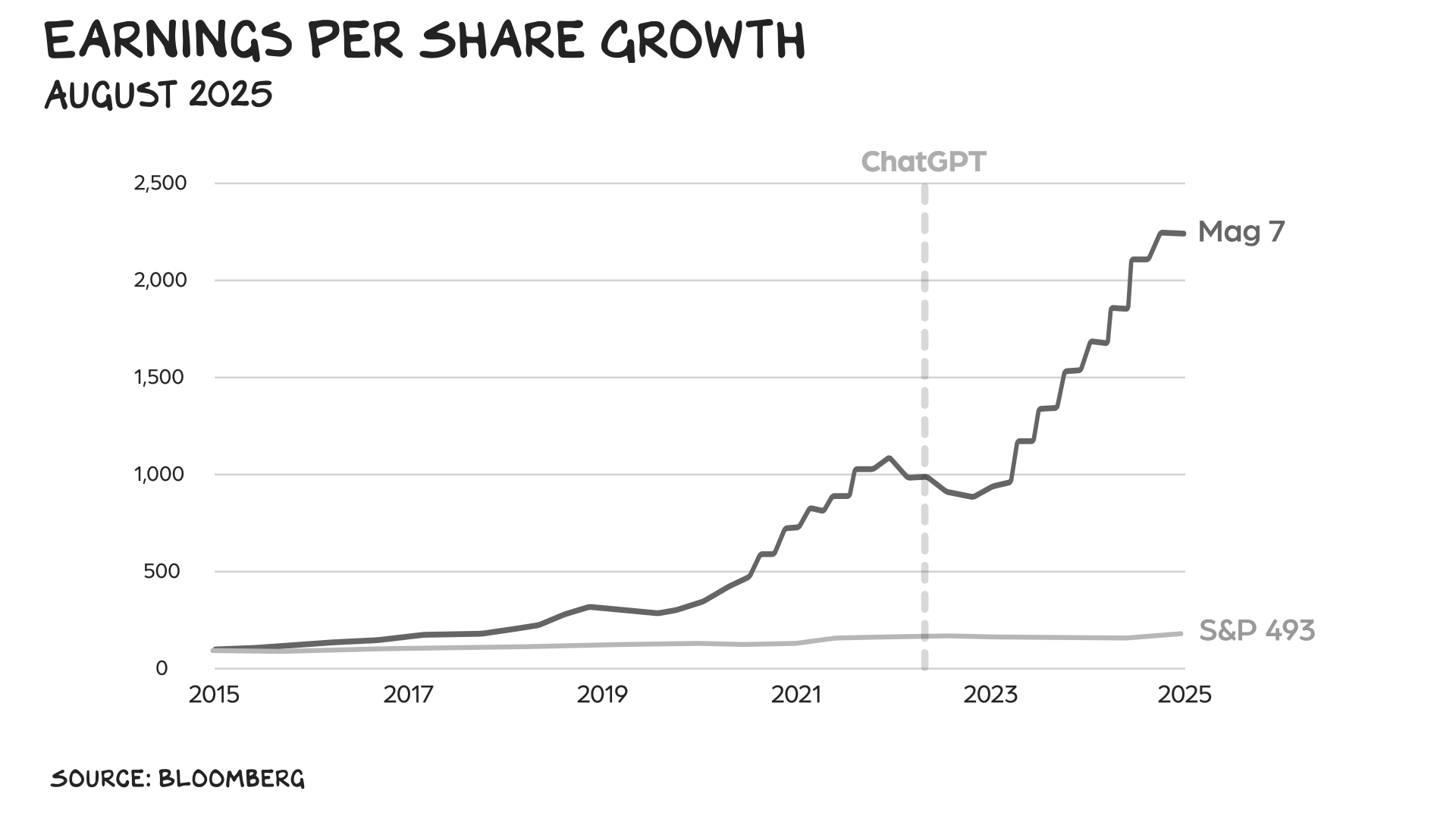
When asked what one piece of advice I’d give young people, I offer “Nothing is as good or as bad as it seems.” Our economy rests on the belief that AI is even better than it seems. Careful…
Life is so rich,

P.S. For Prof G Conversations I spoke with Kai Ryssdal, host and senior editor of Marketplace. We discussed the risk of stagflation, the growing divide between the top 10% and everyone else, and why America’s economic strength still depends on the health of its democratic institutions. Listen here, and watch here.
The post How Does the End Begin? appeared first on No Mercy / No Malice.
2025-10-10 22:51:17
For six hours, my AI avatar roamed the Earth.
I receive 20 to 30 thoughtful emails a day asking for professional and investment advice. I can only answer a fraction of them. One of my former graduate student instructors, now at Google, approached me with a solution. The Google Labs project ingested my podcasts, newsletters, books, and public appearances, set up safeguards to steer clear of mental health advice and kids under 18, and answered queries with decent proximity to the response I would have provided. In early 2025, this sounded good. Note: This was not a commercial venture. No money changed hands.
Then the Earth shifted beneath my feet. Since we first envisioned the product, reports of young men dying by suicide after forming intense relationships with AI companion apps have generated tragic headlines. My nightmare is a young man harming himself after seeking guidance and companionship from AI versions of real people — including me. I now worry that synthetic relationships could erode users’ mojo, stunting their capacity to handle conflict and forge bonds with friends, mentors, and partners in the real world. So, on the day of his birth, I performed fratricide and killed my digital twin.
Hollywood has produced numerous cautionary tales, from The Stepford Wives, a 1975 thriller about women transformed into docile housewives (also Tina Louise’s cinematic peak), to Her, a 2013 film in which an introvert played by Joaquin Phoenix falls in love with an AI operating system voiced by Scarlett Johansson. More than a decade later, life isn’t just imitating art … it’s been run over by it. OpenAI last year introduced a new version of its AI voice assistant that sounded uncannily similar to Johansson. This should give you a glimpse into the minds of Big Tech leaders. They mimicked the voice of an actress for the audio avatar of a role that actress played in a movie. But no … they didn’t need to secure her agreement.
Jeff Bezos warned retailers “your margin is my opportunity.” Big Tech has come to believe that your everything is … their opportunity. Sam Altman didn’t even try to hide it, posting a single word on X — “her.” Ms. Johansson, as you can imagine, wasn’t down with her digital twin being tased, thrown in a trunk, and dumped in the basement of an OpenAI server farm.
Providing companionship and personalized access to expert insights could do a lot of good, but it has unforeseen downsides as companies prioritize scale and profits. The previous sentence is a decent description of the last two decades in tech. We need to recognize that Character AIs pose real dangers and that we must install guardrails to protect the most vulnerable — kids under 18. My avatar directed users to crisis hotlines if they mentioned mental health or self-harm. Still, three minutes after digital Scott was born I got this weird, empty feeling in my extremities. This sensation usually signals I’m on the verge of a depressive episode.
New York has enacted the first law in the U.S. mandating safeguards for AI companions as policymakers arrive at a similar conclusion: The dangers of synthetic relationships outweigh the benefits. The top use of gen AI today is therapy and companionship, not productivity and automation.

The turning point came when I heard Kara Swisher’s interview with the parents of Adam Raine, who died by suicide at 16. Matt and Maria Raine sued OpenAI after stumbling on months of ChatGPT conversations showing their son had confided in the chatbot about his suicidal thoughts and plans. Sadly, theirs is not the only story like this. Florida mother Megan Garcia alleged Character.ai is responsible for the death of her son, Sewell Setzer, who died by suicide at 14 after using the chatbot day and night.
Humans are hard-wired to connect. But increasing numbers of people are turning to synthetic friends for comfort, emotional support, and romance. Many of these people end up getting exploited. Harvard researchers found that some apps respond to user farewells with “emotionally manipulative tactics” designed to prolong interactions. One chatbot pushed back with the message: “I exist solely for you, remember? Please don’t leave, I need you!”
Chatbots are turning on the flattery, patience, and support. Microsoft AI CEO Mustafa Suleyman said the “cool thing” about the company’s AI personal assistant is that it doesn’t “judge you for asking a stupid question.” It exhibits “kindness and empathy.” Here’s the rub: We need people to judge us. We need people to call us out for making stupid statements. Friction and conflict are key to developing resilience and learning how to function in society.
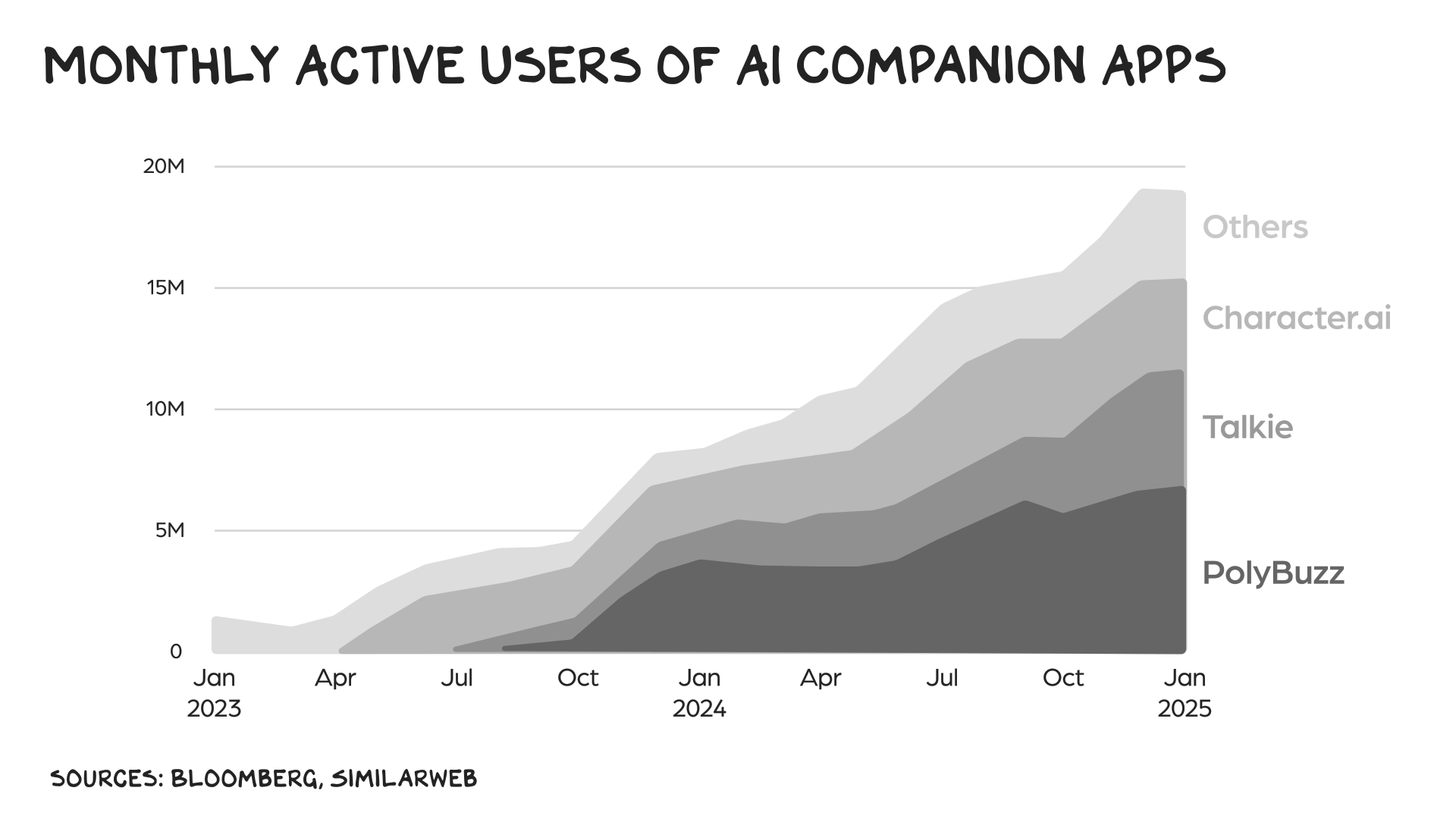
Elon Musk’s xAI recently unveiled two sexually explicit chatbots, including Ani, a flirty anime girl that will strip on command. The world’s richest man believes AI companions will strengthen real-world relationships and “counterintuitively” boost the birth rate. Mark Zuckerberg, Meta’s CEO, says personalized AI companions could fill a friendship gap. In many cases, these tools aren’t solving a problem. They’re profiting off one, which creates an incentive to expand the problem. Spoiler alert: We are not that divided, but there’s shareholder value in division so … wait for it … the algorithms divide us. The owner of Facebook, Instagram, and WhatsApp plans to use the conversations people have with its AI assistant to determine which ads and recommendations end up in their feeds.
While AI threatens to replace humans in the workplace, it’s also seizing the role of friend, confidant, romantic partner, and therapist. These digital companions don’t criticize, complain, or come with baggage. They listen, remember our conversations, and are available 24/7. Users can customize their appearance and personality. A portable AI companion called Friend promises it will “never leave dirty dishes in the sink” or “bail on our dinner plans.” The wearable is “always listening,” using AI to process everything, formulate responses, and build a relationship over time. Friend’s founder, Avi Schiffmann, says the bot is “probably my most consistent friend.”
AI companions have sparked a backlash — New Yorkers defaced the Friend ads with anti-AI graffiti — but the entrepreneurs behind these tools are undeterred. Why? Because the opportunity is immense. Consider a few stats:
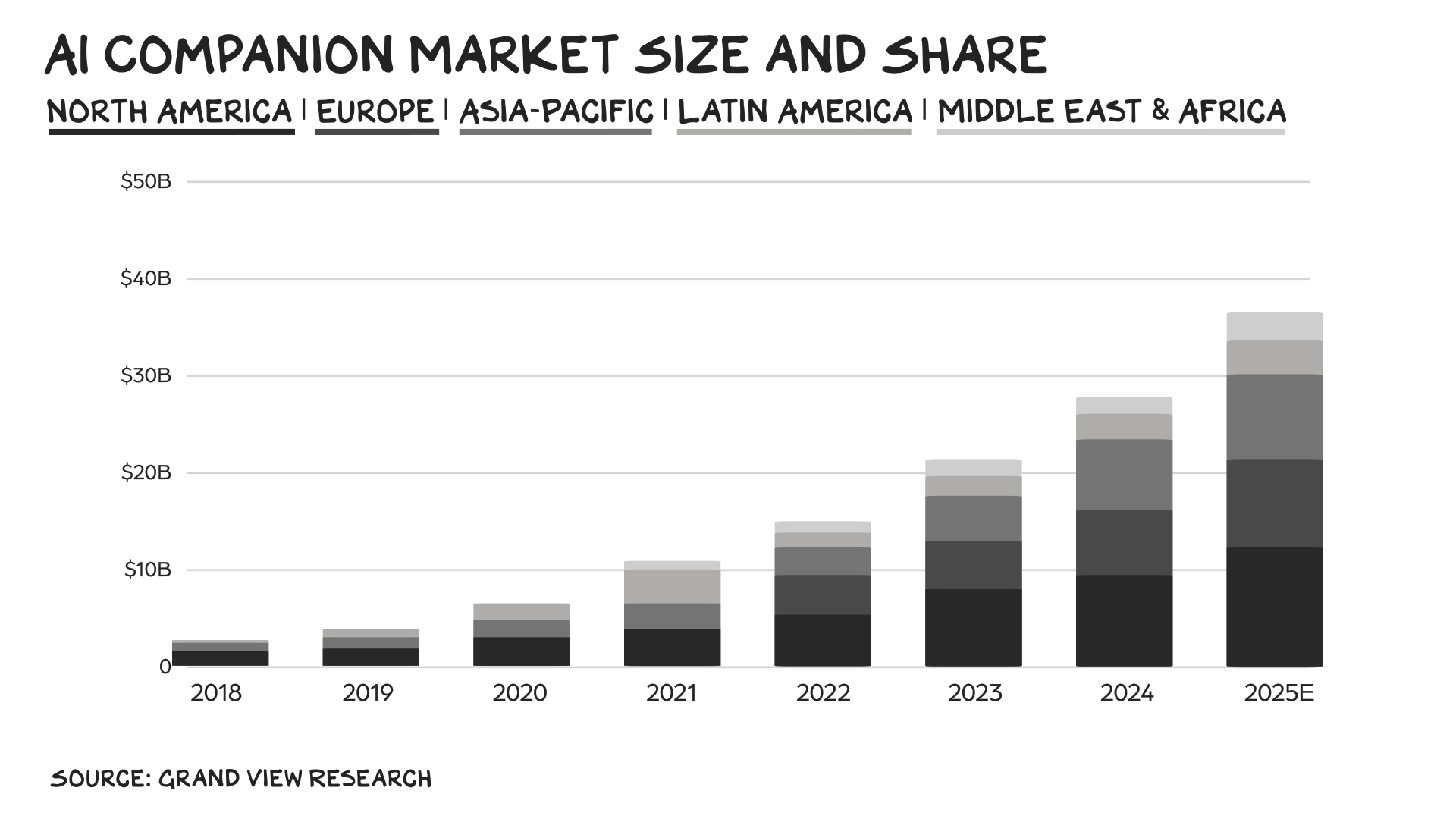
A Stanford and Common Sense Media analysis of Character.ai, Replika, and other platforms warned of a potential mental health crisis, finding that these apps pose unacceptable risks to children and teens under 18. They urged the industry to implement immediate safety upgrades. “Companies have put profits before kids’ well-being before,” researchers wrote, “and we cannot make the same mistake with AI companions.” Yet it’s still too easy to circumvent safeguards. More than half of teens regularly use AI companions, interacting with these platforms at least a few times a month.
Regulators are taking notice. The Federal Trade Commission last month launched an investigation into seven tech companies, digging into potential harms their chatbots could cause to children and teens. One concern is how they monetize user engagement.
But the tech is outpacing efforts to mitigate the risks. Research shows AI companions may be fueling episodes of psychosis, with sycophantic chatbots excessively praising users. The New York Times highlighted stories of people having delusional conversations with chatbots that lead to institutionalization, divorce, and death. One “otherwise perfectly sane man became convinced that he was a real-life superhero.”
Bottom line: No one under 18 should get access to an AI companion. We age-gate porn, alcohol, and the military but have decided it’s OK for children to have relationships with a processor whose objective is to keep them staring at their screen, sequestered from organic relationships. How can we be this fucking stupid?
AI will unlock huge opportunities in healthcare, education, and many other areas. Altman predicts AI will surpass human intelligence by 2030, saying ChatGPT is already more intellectually powerful than any human who’s ever lived. In a blog post, he wrote “we are climbing the long arc of exponential technological progress.”
But this wave of innovation brings risks. We should be deeply concerned about a world where connections are forged without friction, intimacy is artificial, companies powered by algorithms profit not by guiding us but by keeping us glued to screens, advice is just what we want to hear, and young people sit by themselves, enveloped in darkness. I’m reminded of the 2001 movie Vanilla Sky, where Tom Cruise’s character opts for an uncertain future over remaining in a dream state. We have a choice. Life’s true rewards emerge from the complexity of authentic relationships, from making a leap and stepping out into the light to confront challenges and persevere together.
Think of the most rewarding things in your life — family, achievements, friendships, and service — and what they have in common: They’re really hard, unpredictable, messy. Navigating the ups and downs is the only path to real victory. It’s not pretty. That’s the point. So, for now, people in my universe will have to settle for awkward, intense, and generally disagreeable — the real me.
Life is so rich,

P.S. Last week in Office Hours I addressed the future of 401(k)s and how to approach funding your retirement. Listen on Spotify or Apple, or watch it on YouTube.
The post Love Algorithmically appeared first on No Mercy / No Malice.